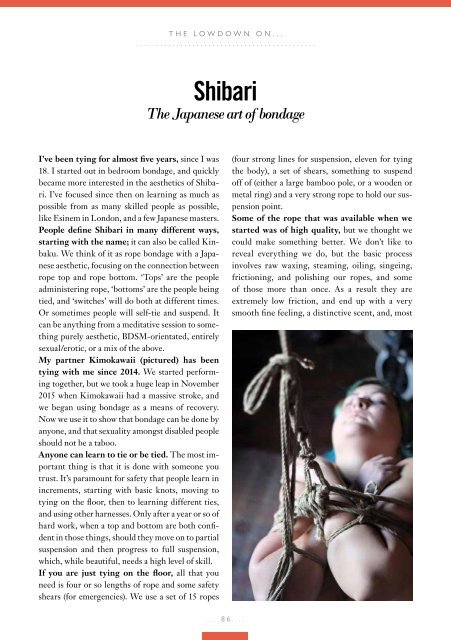Viva Brighton Issue #48 February 2017
Create successful ePaper yourself
Turn your PDF publications into a flip-book with our unique Google optimized e-Paper software.
THE LOWDOWN ON...<br />
.............................................<br />
Shibari<br />
The Japanese art of bondage<br />
I’ve been tying for almost five years, since I was<br />
18. I started out in bedroom bondage, and quickly<br />
became more interested in the aesthetics of Shibari.<br />
I’ve focused since then on learning as much as<br />
possible from as many skilled people as possible,<br />
like Esinem in London, and a few Japanese masters.<br />
People define Shibari in many different ways,<br />
starting with the name; it can also be called Kinbaku.<br />
We think of it as rope bondage with a Japanese<br />
aesthetic, focusing on the connection between<br />
rope top and rope bottom. ‘Tops’ are the people<br />
administering rope, ‘bottoms’ are the people being<br />
tied, and ‘switches’ will do both at different times.<br />
Or sometimes people will self-tie and suspend. It<br />
can be anything from a meditative session to something<br />
purely aesthetic, BDSM-orientated, entirely<br />
sexual/erotic, or a mix of the above.<br />
My partner Kimokawaii (pictured) has been<br />
tying with me since 2014. We started performing<br />
together, but we took a huge leap in November<br />
2015 when Kimokawaii had a massive stroke, and<br />
we began using bondage as a means of recovery.<br />
Now we use it to show that bondage can be done by<br />
anyone, and that sexuality amongst disabled people<br />
should not be a taboo.<br />
Anyone can learn to tie or be tied. The most important<br />
thing is that it is done with someone you<br />
trust. It’s paramount for safety that people learn in<br />
increments, starting with basic knots, moving to<br />
tying on the floor, then to learning different ties,<br />
and using other harnesses. Only after a year or so of<br />
hard work, when a top and bottom are both confident<br />
in those things, should they move on to partial<br />
suspension and then progress to full suspension,<br />
which, while beautiful, needs a high level of skill.<br />
If you are just tying on the floor, all that you<br />
need is four or so lengths of rope and some safety<br />
shears (for emergencies). We use a set of 15 ropes<br />
(four strong lines for suspension, eleven for tying<br />
the body), a set of shears, something to suspend<br />
off of (either a large bamboo pole, or a wooden or<br />
metal ring) and a very strong rope to hold our suspension<br />
point.<br />
Some of the rope that was available when we<br />
started was of high quality, but we thought we<br />
could make something better. We don’t like to<br />
reveal everything we do, but the basic process<br />
involves raw waxing, steaming, oiling, singeing,<br />
frictioning, and polishing our ropes, and some<br />
of those more than once. As a result they are<br />
extremely low friction, and end up with a very<br />
smooth fine feeling, a distinctive scent, and, most<br />
....86....


















